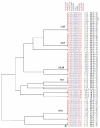Closely linked cis-acting modifier of expansion of the CGG repeat in high risk FMR1 haplotypes
- PMID: 17674408
- PMCID: PMC2683060
- DOI: 10.1002/humu.20600
Closely linked cis-acting modifier of expansion of the CGG repeat in high risk FMR1 haplotypes
Abstract
In its expanded form, the fragile X triplet repeat at Xq27.3 gives rise to the most common form of inherited mental retardation, fragile X syndrome. This high population frequency persists despite strong selective pressure against mutation-bearing chromosomes. Males carrying the full mutation rarely reproduce and females heterozygous for the premutation allele are at risk of premature ovarian failure. Our diagnostic facility and previous research have provided a large databank of X chromosomes that have been tested for the FRAXA allele. Using this resource, we have conducted a detailed genetic association study of the FRAXA region to determine any cis-acting factors that predispose to expansion of the CGG triplet repeat. We have genotyped SNP variants across a 650-kb tract centered on FRAXA in a sample of 877 expanded and normal X chromosomes. These chromosomes were selected to be representative of the haplotypic diversity encountered in our population. We found expansion status to be strongly associated with a approximately 50-kb region proximal to the fragile site. Subsequent detailed analyses of this region revealed no specific genetic determinants for the whole population. However, stratification of chromosomes by risk subgroups enabled us to identify a common SNP variant which cosegregates with the subset of D group haplotypes at highest risk of expansion (chi(1)(2)=17.84, p=0.00002). We have verified that this SNP acts as a marker of repeat expansion in three independent samples.
(c) 2007 Wiley-Liss, Inc.
Figures


Similar articles
-
Fragile X founder effects and new mutations in Finland.Am J Med Genet. 1996 Jul 12;64(1):226-33. doi: 10.1002/(SICI)1096-8628(19960712)64:1<226::AID-AJMG41>3.0.CO;2-M. Am J Med Genet. 1996. PMID: 8826481
-
Assessment of a clinical checklist in the diagnosis of fragile X syndrome in India.J Clin Neurosci. 2009 Oct;16(10):1305-10. doi: 10.1016/j.jocn.2008.12.018. Epub 2009 Jun 27. J Clin Neurosci. 2009. PMID: 19560928
-
The Fragile X premutation: new insights and clinical consequences.Eur J Med Genet. 2006 Jan-Feb;49(1):1-8. doi: 10.1016/j.ejmg.2005.11.001. Epub 2005 Dec 5. Eur J Med Genet. 2006. PMID: 16473304 Review.
-
Re-examination of factors associated with expansion of CGG repeats using a single nucleotide polymorphism in FMR1.Hum Mol Genet. 1998 Nov;7(12):1935-46. doi: 10.1093/hmg/7.12.1935. Hum Mol Genet. 1998. PMID: 9811938
-
[Chromatin changes caused by CGG repeat expansion in fmr1 gene].Mol Biol (Mosk). 2015 Mar-Apr;49(2):205-11. Mol Biol (Mosk). 2015. PMID: 26065250 Review. Russian.
Cited by
-
Repeat instability during DNA repair: Insights from model systems.Crit Rev Biochem Mol Biol. 2015 Mar-Apr;50(2):142-67. doi: 10.3109/10409238.2014.999192. Epub 2015 Jan 22. Crit Rev Biochem Mol Biol. 2015. PMID: 25608779 Free PMC article. Review.
-
Genetic diversity of the fragile X syndrome gene (FMR1) in a large Sub-Saharan West African population.Ann Hum Genet. 2010 Jul;74(4):316-25. doi: 10.1111/j.1469-1809.2010.00582.x. Ann Hum Genet. 2010. PMID: 20597902 Free PMC article.
-
Cis- and Trans-Modifiers of Repeat Expansions: Blending Model Systems with Human Genetics.Trends Genet. 2018 Jun;34(6):448-465. doi: 10.1016/j.tig.2018.02.005. Epub 2018 Mar 19. Trends Genet. 2018. PMID: 29567336 Free PMC article. Review.
-
Ups and Downs: Mechanisms of Repeat Instability in the Fragile X-Related Disorders.Genes (Basel). 2016 Sep 21;7(9):70. doi: 10.3390/genes7090070. Genes (Basel). 2016. PMID: 27657135 Free PMC article. Review.
-
Contraction of fully expanded FMR1 alleles to the normal range: predisposing haplotype or rare events?J Hum Genet. 2017 Feb;62(2):269-275. doi: 10.1038/jhg.2016.122. Epub 2016 Oct 27. J Hum Genet. 2017. PMID: 27784894
References
-
- Avramova Z, Georgiev O, Tsanev R. DNA sequences tightly bound to proteins in mouse chromatidentification of murine MER sequences. DNA Cell Biol. 1994;13:539–548. - PubMed
-
- Bontekoe CJ, Bakker CE, Nieuwenhuizen IM, van der LH, Lans H, de LD, Hirst MC, Oostra BA. Instability of a (CGG)98 repeat in the Fmr1 promoter. Hum Mol Genet. 2001;10:1693–1699. - PubMed
-
- Brightwell G, Wycherley R, Potts G, Waghorn A. A high-density SNP map for the FRAX region of the X chromosome. Single-nucleotide polymorphisms. J Hum Genet. 2002;47:567–575. - PubMed
Publication types
MeSH terms
Substances
Grants and funding
LinkOut - more resources
Full Text Sources
Medical

